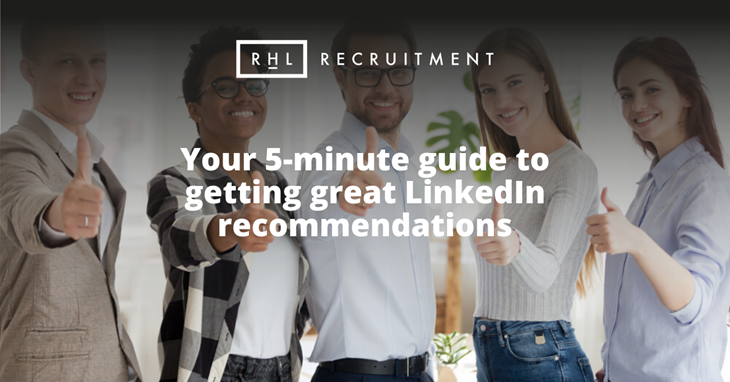Your 5-minute guide to getting great LinkedIn recommendations

Many employers will check out your presence on LinkedIn before offering you a job, so having plenty of positive recommendations packs a powerful punch.
LinkedIn recommendations boost your credibility, acting as social proof that you have the skills and experience you claim in your profile (and backing up how you present yourself during the interview stage).
And as they’re posted directly by whoever’s recommended you, they’re strong on legitimacy. Having a trusted professional vouch for your specialist expertise and sector-specific skills can make you a stronger candidate, as we know in our work recruiting technical talent at RHL.
But there’s an art to asking for high-quality recommendations - and getting ones that do you justice...
Be selective
At first glance, 20 recommendations packed onto your LinkedIn page might look more impressive than just a handful. But choose quality over quantity.
The best ones are personal, specific and also include measurable results. So aim for contacts you have a good relationship with, who can vouch for your work or skills - whether you’ve worked with them in the past or do so currently. It goes without saying that these should be people who like and rate you.
That might be:
- A manager who thinks highly of you
- A colleague who can vouch for how you are to work with
- A client who can speak about deliverables
- A co-worker on a short project that’s relevant to your career
Plan what you want to cover
Are there individual strengths, skills or qualities you’d like your LinkedIn recommendations to draw attention to? How about your performance on specific projects or how you coped with a particular set of work challenges?
Draw up a recommendations wishlist, then choose different connections most likely to be able to fulfil them.
Email first
When you’re planning to ask someone for a recommendation, you’ll get better results if you first email them to check they’re OK with this.
LinkedIn message notifications often get turned off, or ignored - but that’s not the only reason to try a different approach. Sending an email makes your request more personal - and when it comes to recommendations, the more personal the results the better.
Make it easy for people
Your connections are probably happy to write a recommendation for you, but they’re busy so make it easy for them to deliver what you need.
When you request a recommendation, feel free to remind them of specific occasions when you showed the skills or attributes you want them to include. For example:
“I enjoyed working on the [insert name] contract with you earlier in the year. If you get a chance, please could you write a few short paragraphs describing my contribution and how that impacted the success of the overall project? I’m particularly proud of the fact that we finished ahead of time and under budget, and it’d be great to mention that.”
“Thanks for the feedback on the [insert name] project recently - it’s great to hear that everyone is happy with the results. Would you mind writing me a recommendation that highlights my [insert specific] skills, and the results I managed to achieve please?”
Make it a habit
At RHL we wrote recently about why it’s vital to keep your LinkedIn profile up-to-date and ready to go, rather than just when you’re job hunting. The same goes for recommendations. Aim to approach trusted connections every few months, perhaps after you’ve accomplished something specific or finished a certain project.
You never know who may look at your profile and - thanks to some meaningful insights from someone you’ve worked with - decide you could be right for their team.
